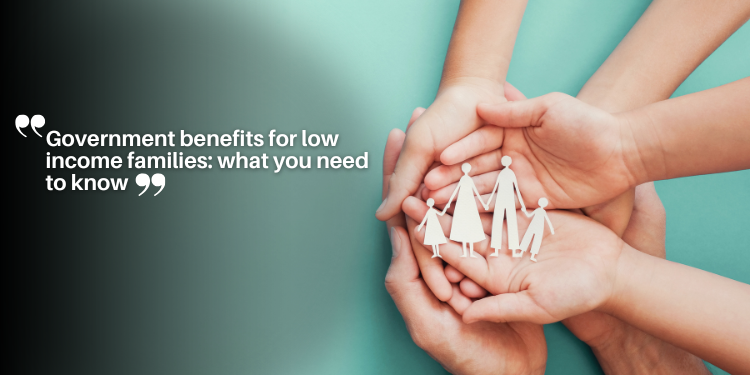Government benefits for low income families: what you need to know

Government benefits for low income families include food assistance, healthcare coverage, and housing support, all aimed at improving financial stability and access to essential resources.
Government benefits for low income families play a crucial role in ensuring households have access to essential resources. Have you ever wondered how these programs can make a difference in your life? Let’s dive in and explore.
Understanding government benefits
Understanding government benefits can be a bit complicated, but it’s essential for families who need support. Programs are available to help those with low incomes.
These benefits can cover various needs like food, housing, and healthcare. Let’s break down how these programs work.
Types of Government Benefits
There are several types of government benefits designed for families in need:
- Food assistance programs like SNAP.
- Healthcare coverage such as Medicaid.
- Temporary Assistance for Needy Families (TANF).
- Housing assistance programs.
These options vary by state and can provide vital resources. Knowing which ones apply to you is crucial.
How Benefits Help Families
Government benefits are more than just financial support; they offer stability and peace of mind. For example, food assistance can ensure your family has enough to eat every month.
Additionally, housing support allows families to find a place to live without spending all their income on rent. With healthcare benefits, families can access necessary medical services without the burden of high costs.
Overall, understanding these benefits empowers families to improve their quality of life. If you believe you might qualify for any of these programs, looking into them could make a significant difference.
Types of benefits available
There are various types of benefits available that assist low-income families. Understanding these programs is key to accessing the help you need. Each type serves a different purpose and can greatly impact your family’s wellbeing.
Food Assistance
One of the most crucial types is food assistance. Programs like SNAP (Supplemental Nutrition Assistance Program) help ensure that families can afford healthy meals each month.
- Provides monthly benefits for groceries.
- Eligibility is based on income and household size.
- Can be used at most grocery stores.
With this support, families can reduce the stress of planning meals on a tight budget.
Healthcare Benefits
Healthcare benefits are also essential. Medicaid and CHIP (Children’s Health Insurance Program) provide coverage for low-income families, ensuring children and adults have access to necessary medical care.
These programs cover a range of services, from regular check-ups to emergency care, making healthcare more accessible.
The process to enroll may vary, so it’s important to check your state’s guidelines to see what is available.
Housing Assistance
Housing assistance programs offer vital support to families struggling to pay rent. Programs like Section 8 provide vouchers that help cover housing costs.
- Reduces the financial burden of monthly rent.
- Helps families find safe and stable housing.
- Eligibility is typically income-based.
Understanding these types of benefits can help you identify which programs you might qualify for, leading to a more secure living situation.

Eligibility requirements explained
Understanding the eligibility requirements for government benefits is essential for families seeking assistance. Each program has specific guidelines that determine who can apply and receive these valuable resources. Generally, eligibility is based on income, household size, and other factors.
Income Limits
Most benefits are designed for low income families. This means that there’s an income threshold that applicants must not exceed. Programs like SNAP and Medicaid have adjusted limits that may vary by state.
- Income is usually calculated based on the gross yearly amount.
- There are different limits for households based on size.
- Additional deductions, like childcare costs, may apply.
It’s important to check the exact limits for your area to understand if you qualify.
Household Size
The size of your household is another key factor for eligibility. Generally, larger households may have higher income limits because they require more resources.
When applying, you’ll need to provide information about all members living in your home. This includes income details for everyone to determine the correct eligibility.
Other Factors
Some programs consider other factors like residency status, age, or disability. For instance, certain benefits are specifically aimed at children or individuals with disabilities.
Additionally, some programs might require proof of employment or participation in job training. Understanding these factors can help families determine which programs they may be eligible for, making it easier to access the assistance they need.
How to apply for assistance
Applying for assistance can seem daunting, but understanding the process makes it simpler. Knowing how to apply for assistance for government benefits can help low-income families access the resources they need.
Gather Necessary Documents
Before starting your application, gather the required documents. Important papers might include proof of income, identification, and information about your household size.
- Pay stubs or tax returns can serve as proof of income.
- Identification may include a driver’s license or Social Security card.
- Documents showing household members, such as birth certificates.
Having everything ready will speed up the process and increase your chances of success.
Choose Your Application Method
There are various ways to apply for government assistance. You can usually choose between online applications, phone applications, or in-person visits.
Many states offer online portals where you can fill out and submit applications securely. Alternatively, contacting your local agency by phone can provide guidance and allow you to apply verbally.
If you prefer face-to-face help, visiting local offices may also be a good option. Staff members there can assist you with the paperwork and answer any questions.
Understand the Review Process
Once you submit your application, it will be reviewed by officials who determine your eligibility. This process may take a few weeks, depending on the program.
After the review, you’ll receive a notification of approval or denial. If you qualify, you will receive information about your benefits and when to expect assistance.
If your application is denied, you have the right to appeal. Knowing the application process and what to expect can help you navigate this experience with confidence.
FAQ – Frequently Asked Questions about Government Benefits for Low Income Families
What types of government benefits are available for low income families?
Low income families can access various benefits like food assistance (SNAP), healthcare coverage (Medicaid), and housing assistance programs.
How do I know if I am eligible for government benefits?
Eligibility is usually based on income, household size, and other factors. It’s important to check specific program guidelines for the most accurate information.
What documents do I need to apply for government assistance?
You’ll typically need documents such as proof of income, identification, and information about your household, like size and residency.
How can I apply for government assistance?
You can apply online, by phone, or in-person at local offices. Choose the method that is most convenient for you and gather your necessary documents beforehand.







